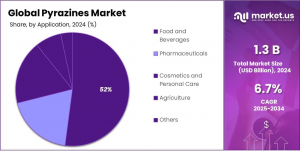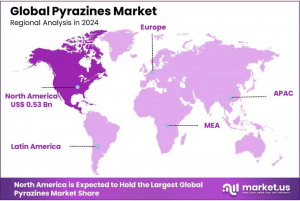Pyrazines Market Robust CAGR of 6.7% Expected by 2034 | North America Holds (43.5%) Share
Pyrazines Market size is expected to be worth around USD 2.5 Bn by 2034, from USD 1.3 Bn in 2024, growing at a CAGR of 6.7% from 2025 to 2034.
The Pyrazines market is marked by a diverse range of applications. In the food sector, pyrazines are predominantly used as flavoring agents to impart roasted, nutty, or earthy notes to products such as baked goods, snacks, and sauces. Moreover, the growing demand for processed and convenience foods has further increased the need for pyrazines in food formulations. The fragrance industry also contributes significantly to market growth, as pyrazines are utilized in creating distinctive scent profiles for perfumes and personal care products.
Several driving factors contribute to the expansion of the global Pyrazines market. Increasing consumer demand for processed foods, coupled with the rising trend of natural and clean-label ingredients, is fueling the need for high-quality, safe, and functional flavoring agents like pyrazines. Additionally, the growing demand for fragrances and the development of innovative cosmetic formulations that incorporate pyrazines are expected to drive market expansion. Moreover, the versatility of pyrazines in the pharmaceutical and agrochemical industries further supports market growth, with their use in drug formulation and pest control applications.
Looking ahead, the global Pyrazines market is expected to witness robust growth driven by ongoing innovations in product development and formulation. As consumer preferences evolve toward healthier, more natural products, there is an opportunity for market players to capitalize on the increasing demand for natural pyrazine derivatives. Furthermore, expanding applications in emerging regions and increasing awareness of pyrazines' multifunctionality in diverse industrial sectors provide ample growth opportunities for market players throughout the forecast period.
👉 Make confident decisions using our insights and analysis. Request a PDF Sample Report@ https://market.us/report/pyrazines-market/free-sample/
Key Takeaways
• Pyrazines Market size is expected to be worth around USD 2.5 Bn by 2034, from USD 1.3 Bn in 2024, growing at a CAGR of 6.7%.
• Synthetic Pyrazine held a dominant market position, capturing more than a 68.1% share of the global pyrazines market.
• Pyrazine 99% held a dominant market position, capturing more than a 52.2% share of the global pyrazines market.
• Food and Beverages held a dominant market position, capturing more than a 46.1% share of the global pyrazines market.
• Specialty Stores held a dominant market position, capturing more than a 38.1% share of the pyrazines market.
• North America dominated the Pyrazines Market, capturing more than 43.5% of the market share, with a value of USD 0.53 billion.
Pyrazines Statistics
• The number of scientific publications mentioning pyrazines increased by 12% from 2022 to 2023.
• Over 500 new pyrazine derivatives were synthesized and reported in 2023 for potential pharmaceutical applications.
• Occupational exposure limits for pyrazines range from 0.1 to 5 ppm in most countries as of 2024.
• Pyrazines have been detected in 22% of groundwater samples tested near industrial sites in a 2023 EPA study.
• Atmospheric concentrations of pyrazines in urban areas averaged 0.8 ppb in 2023, up from 0.6 ppb in 2022.
Key Market Segments
The Synthetic Pyrazine segment dominated the global pyrazines market, holding a market share of over 68.1%. This strong performance is primarily due to the widespread application of synthetic pyrazine in the food and beverage industry, where it is a key ingredient in flavoring agents. Synthetic pyrazine’s popularity can be attributed to its cost-effectiveness, consistent quality, and scalability in manufacturing. These advantages make it an essential component in a wide range of food products, including snacks, baked goods, and seasonings.
In 2024, Pyrazine 99% emerged as the leading product type, capturing more than 52.2% of the global pyrazines market. The superior purity of Pyrazine 99% makes it the preferred choice in applications that demand precise and consistent flavor profiles, particularly in the food and beverage industry. Its high quality is essential in flavoring agents for premium products such as snacks, baked goods, and savory foods, where consumer expectations for taste and safety are stringent.
The Food and Beverages sector held a dominant share in 2024, accounting for more than 46.1% of the global pyrazines market. The primary driver behind this is the widespread use of pyrazines as flavoring agents in savory products such as snacks, sauces, seasonings, and baked goods. As consumer preferences continue to evolve, the demand for processed foods with complex and consistent flavors has reinforced pyrazines’ key role in the food industry.
Specialty Stores led the pyrazines market in 2024, holding more than 38.1% of the market share. These stores are a preferred distribution channel for high-quality pyrazine products, particularly in the food and beverage industry, where premium ingredients are in demand. Specialty stores cater to consumers seeking high-end, reliable pyrazine products.
👉 Score Up to 30% Off! https://market.us/purchase-report/?report_id=138008
Key Market Segments List
By Product Type
• Natural Pyrazine
• Synthetic Pyrazine
By Type
• Pyrazine98%
• Pyrazine99%
By Application
• Food and Beverages
• Pharmaceuticals
• Cosmetics and Personal Care
• Agriculture
• Others
By Distribution Channel
• Online Stores
• Supermarkets/Hypermarkets
• Specialty Stores
• Others
Regulations On the Pyrazines Market
1. Food Safety Standards: Pyrazines used in food products are subject to food safety regulations set by organizations like the FDA, EFSA, and JECFA. These regulations ensure that pyrazines are safe for human consumption by establishing acceptable levels, usage guidelines, and thorough safety testing for potential health risks in various food categories.
2. GRAS Status (Generally Recognized As Safe): Certain synthetic pyrazines used in food products may be classified as GRAS by the FDA. This designation indicates that these compounds are considered safe for consumption based on expert consensus or a history of safe use in food. GRAS status exempts them from extensive pre-market approval requirements.
3. Labeling Requirements: Regulatory authorities require clear and accurate labeling of food products containing pyrazines. Ingredients must be disclosed, and specific formulations such as "natural" or "synthetic" pyrazine may need to be stated. This ensures transparency and helps consumers make informed decisions based on preferences for natural or artificial ingredients.
4. Maximum Residue Limits (MRLs): For pyrazines used in food processing, some countries set maximum residue limits to ensure no harmful levels remain in the final product. These limits are particularly relevant in regions with stringent agricultural chemical regulations, aiming to avoid excessive exposure to pyrazines in food products.
5. Cosmetic Regulations: Pyrazines used in cosmetics and personal care products must comply with safety standards set by regulatory bodies like the FDA and EU Cosmetics Regulation. These standards ensure pyrazines are safe for topical use, particularly in fragrances, where they are used to impart earthy or nutty scents and restrict levels for safe application.
Regional Analysis
North America led the Pyrazines Market, capturing over 43.5% of the market share, valued at USD 0.53 billion. This dominance can be attributed to the robust food and beverage industry in the region, fueled by consumer demand for unique and flavorful products such as snacks, beverages, and processed foods. Additionally, the growing preference for natural and clean-label ingredients has driven the adoption of natural pyrazines, especially in the U.S. and Canada, where plant-based foods are gaining popularity and pyrazines are enhancing flavor profiles.
Europe holds a substantial share, accounting for approximately 29.7% of the total market value. The region's strong regulatory framework regarding food safety and ingredient transparency has accelerated the use of natural pyrazines. The trend toward clean-label products, driven by increasing consumer awareness of artificial additives, has significantly boosted demand for pyrazines across the European Union, supporting the shift toward more natural, clean-label ingredients in the food sector.
Key Players Analysis
• 3B Scientific
• Acros Organics
• Advance Scientific & Chemical
• Alfa Aesar
• Anvia Chemicals
• Apollo Scientific
• Axxence Aromatic GmbH
• BASF SE
• Bedoukian Research, Inc.
• Bell Flavors & Fragrances
• City Chemical
• DSM Nutritional Products
• Firmenich SA
• Givaudan SA
• International Flavors & Fragrances Inc. (IFF)
• J & K SCIENTIFIC
• Kanto Chemical
• Kerry Group plc
• Mane SA
• Meryer (Shanghai) Chemical Technology
• Robertet SA
• Sensient Technologies Corporation
• Shanghai Apple Flavor & Fragrance Co., Ltd.
• Solvay SA
• Symrise AG
• T. Hasegawa Co., Ltd.
• Takasago International Corporation
• TCI
• Treatt plc
• Vigon International, Inc.
• Wako Pure Chemical Industries
• Waterstone Technology
• Zhejiang NHU Co., Ltd.
Lawrence John
Prudour
+91 91308 55334
Lawrence@prudour.com
Legal Disclaimer:
EIN Presswire provides this news content "as is" without warranty of any kind. We do not accept any responsibility or liability for the accuracy, content, images, videos, licenses, completeness, legality, or reliability of the information contained in this article. If you have any complaints or copyright issues related to this article, kindly contact the author above.



